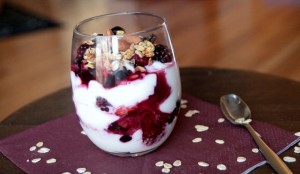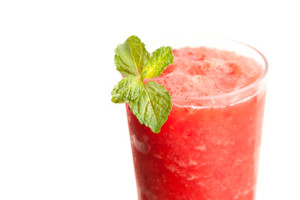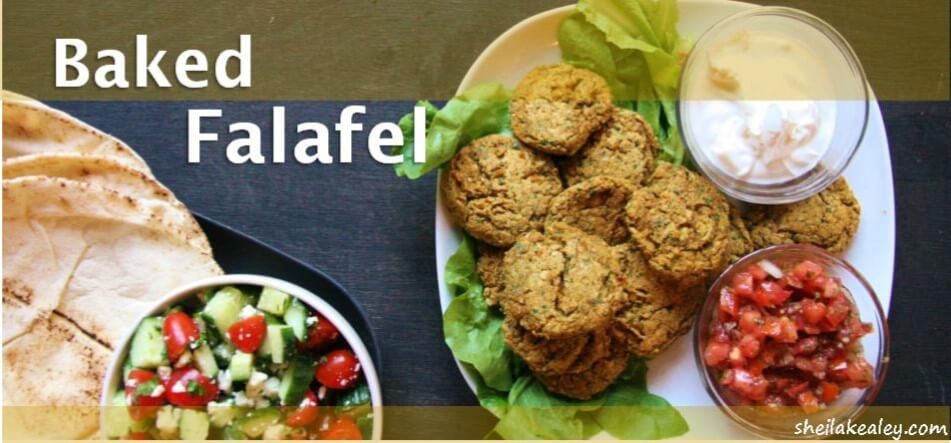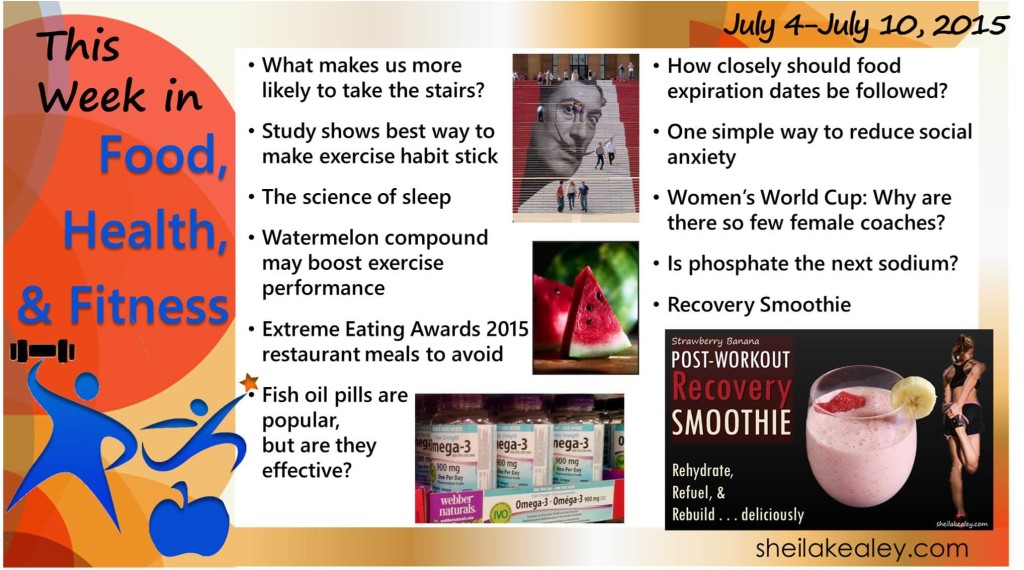This week, read about strength training to improve bone density, how to recover from an all-nighter, exercise to reduce breast cancer risk, yogurt, ice slushies for heat training, drinking between workouts, muscle knots, Isagenix, and more.
Strength Training for Bone Density
Although muscle immediately comes to mind when people think of strength training, increased bone density is another benefit, but not as well studied. This week, two news stories reported on completed or ongoing studies.
University of Missouri researchers completed a study that provides more evidence for the bone-building benefits of lifting weights in physically active men with low bone mass. The men completed either a weight-lifting program or a jumping program for a year, that included 1 to 2 hours weekly of targeted exercises. Whole body and lumbar spine bone mass increased significantly for both the weight-lifting or jumping programs, and hip-bone density only increased among those who completed the weight-lifting program. (The Bone Journal, June 2015)
There were a few news reports this week of an ongoing study in Australia that is comparing the muscle and bone effects of high load resistance training vs low load resistance training (the Liftmor Study). Check out the video in this news story – these women aren’t lifting little dumbbells!
How to Recover from an All-Nighter
If this is something you need to do, be sure you read Maria Konnikova’s great article (the Walking Dead) first.
Then, check out this video, where sleep scientist (reluctantly) share research-backed advice for getting through your day on little to no sleep. (New York Magazine, The Science of Us)
More Exercise is Better to Lower Breast Cancer Risk
Body fat doesn’t just sit there. It is metabolically active: fat cells produce hormones that affect our disease risk and overall health. Over the last decade research has shown that body fat plays an important role in the development of many types of cancer. In fact, excess body fat is one of the strongest predictors of increased risk for postmenopausal breast cancer. Fat cells produce a number of factors that increase cancer risk: fat cells produce estrogen (which promotes cell growth), and certain proteins that increase inflammation and insulin resistance, which are implicated in cancer risk.
Exercise helps reduce body fat and a large body of evidence shows that physical activity reduces breast cancer risk. A new study out this week, reported by Time Magazine, looks at how much women need to exercise necessary to reduce risk. Researchers from the University of Calgary and University of Alberta found that women assigned to exercise for 300 minutes a week lost more body fat than women assigned to exercise for 150 minutes weekly in the year-long study. (JAMA Oncology, July 2015).
 For the love of yogurt. Yogurt lover or not, you are bound to learn something new if you listen or read through NPR’s terrific series on yogurt. (NPR, the Salt).
For the love of yogurt. Yogurt lover or not, you are bound to learn something new if you listen or read through NPR’s terrific series on yogurt. (NPR, the Salt).
- We Didn’t Build This City On Rock ‘N’ Roll. It Was Yogurt
- The Fall Of A Dairy Darling: How Cottage Cheese Got Eclipsed By Yogurt
- Hey Yogurt-Maker, Where’d You Get Those Microbes?
- The ‘Immortal’ Homemade Yogurt That Traveled ‘Round The World
- Prozac In The Yogurt Aisle: Can ‘Good’ Bacteria Chill Us Out?
- Does Iceland Need New Cows To Keep Up With Demand For Skyr?
- A Crime Of Passion: When The Love Of Yogurt Burned Too Bright
Anti-inflammatories increase heart attack and stroke risk. This week, the FDA strengthened its warning on non steroidal anti-inflammatory medications (NSAIDs) regarding the increased risk of heart-attack and stroke. Over-the-counter NSAIDs include ibuprofen (Motrin, Advil) and naproxen (Aleve); prescription NSAIDs include celecoxib (Celebrex), diclofenac (Cataflam, Voltaren); Aspirin is also an NSAID, but it does not pose risks to heart health. Many athletes take NSAIDs for muscle pains associated with training, or some injuries without considering other implications. Some even take NSAIDs during race events. Amby Burfoot at Runners World puts this in perspective for athletes. Just because something is commonly used and available over the counter, doesn’t mean it is safe and without side effects. (Harvard Health Publications, Runner’s World).
 Ice slushies for heat training. An increasing amount of research is looking into lowering your body’s temperature for better performance in hot weather. This new study provides
Ice slushies for heat training. An increasing amount of research is looking into lowering your body’s temperature for better performance in hot weather. This new study provides
more evidence that supports drinking ice slushies to cool for endurance performance in the heat. (Scand J Med Sci Sports Jun 2015).
Drinking between workouts. As hydration guidelines evolve, your fluid intake between runs matters more. (Alex Hutchinson, Runner’s World)
Tired, injured, & underperforming? You might not be eating enough. Sports dietitian Jennifer Sygo wrote an excellent column explaining relative energy deficiency in sport (REDS). If you are not eating enough to support your physical activity, your performance (and health) will suffer. (Jennifersygo.com)
What are muscle “knots” actually made of & can they be prevented? Gretchen Reynolds looks at the evidence for and treatment of muscle knots. (Gretchen Reynolds, New York Times).
Does Isagenix Help You Lose Weight, or Lose Your Money? Isagenix is an expensive meal replacement program involving shakes, bars, and herbal supplements that relies on multilevel marketing often via social media or email to promote its product. The product boasts “nutritional cleansing,” “detox” and is essentially a low-calorie diet that might promote short-term weight loss. Research has repeatedly shown that weight loss that relies on meal replacements and low calories is difficult to sustain, since it doesn’t change habits. Also, why spend a whole lot of money on low-calorie shakes and supplements when you can choose real foods that are inexpensive, fit into regular daily habits, and have proven nutritional benefits? This week, Fooducate looks at this expensive system of shakes, powders, and weight loss products, and reminds us that “there are no shortcuts to permanent weight loss.” (Fooducate)
Here are other evidence-based reviews of Isagenix:
- Isagenix under the microscope. (CHOICE online)
- Isagenix Study Is Not Convincing (Science-Based Medicine)
- Defending Isagenix: A Case Study in Flawed Thinking (Science-Based Medicine)
New Recipe on the Blog: Baked Falafel
A healthy twist on this Middle Eastern favourite.
Last Week in Food, Health, and Fitness
Share This:

